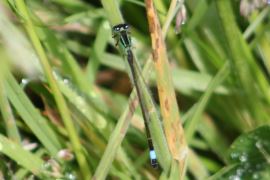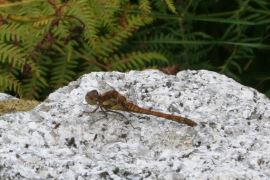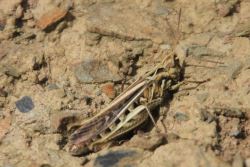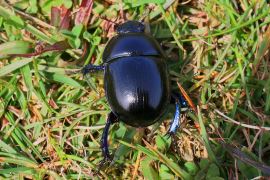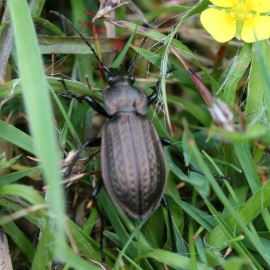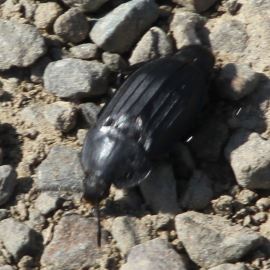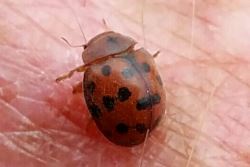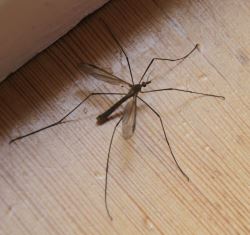A wide range of invertebrates can be found on Lundy. Over the years around 1500 species have been recorded in Annual Reports by casual and specialist surveyors. Many Groups are represented, Spiders, Woodlice, Myriapods, Damselflies and Dragonflies, Grasshoppers and Crickets, True Bugs, Beetles, Flies, and Bees Wasps and Ants.
An exhaustive list is not attempted here but the more common and visible species are described and, where possible, illustrated. Click on any image to view a larger version.
Each Class has a link to the definitive list of species recorded on Lundy, where their status is described using the DAFOR scale:
- Dominant 50-100%
- Abundant 30-50%
- Frequent 15-30%
- Occasional 5-15%
- Rare < 5%
We have used this scale to indicate what percentage of years the species has been recorded on Lundy. Please treat these assesments with caution as much depends on there being a specialist present on Lundy when the species is liable to been seen and on whether this results in a record being entered in the LFS log book. Most species are severely under-recorded and all records are welcome.
Molluscs
While slugs are abundant in damp weather, which is not uncommon on Lundy, they are very under recorded. Similarly, whilst the large Garden and Brown-lipped Snails can be easily found records are rarely seen in the log book. The remaining snails are quite small and can only usually be found by diligent stone turning or wall inspection. The Lundy list of Terrestrial molluscs can be viewed here.
Spiders (Arachnida)
Two spiders are, if not common, easily found. The Cave Spider can be searched for in Benson’s Cave or the Cave along the Landing Beach.
The Cellar Spider is easily confused with Daddy Long-legs. As a spider it has 8 not 6 long spindly legs. It can be found in the upper corners of most properties and should be cherished as it not only eats flies, but also other spiders.
View the Lundy list of Spiders, Harvestmen and Mites here.
Woodlice (Isopoda)
The Common Shiny Woodlouse Oniscus asellus is found all over the island, but a rather more interesting yet easily found species is the Ant Woodlouse Playarthus hoffmannseggi. Whilst looking for ants under stones, you might chance upon this tiny white wood louse. Don’t be fooled into thinking this is a juvenile, it is fully grown at 4 mm and pure white. View the lundy list of Woodlice here.
Myriapods - Millipedes, Centipedes (Diplopoda and Chilopoda)

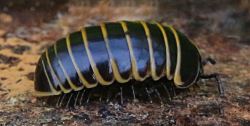 There is one centipede that can usually be seen indoors and under stones, but it is very fast moving. The Banded Centipede Lithobius variegatus is extremely common and quite large. Its distinctive banded purple legs easily identify it.
There is one centipede that can usually be seen indoors and under stones, but it is very fast moving. The Banded Centipede Lithobius variegatus is extremely common and quite large. Its distinctive banded purple legs easily identify it.
The Pill Millipede Glomeris marginata (not to be confused with the Pill Woodlouse Armadillidium vulgare – check the number of legs) is very common on the Lower East Side Path to the north of Halfway Wall. It has 2 pairs of legs per segment, rolls into a almost perfect sphere and, on Lundy, shows yellow edges to each segment.
The Lundy list of Centipeded and Millipedes can be viewed here.
Dragonflies and Damselflies (Odonata)
Out of 57 UK species, 14 have been reported from Lundy (see article in 2015 Annual Report and the Lundy list here). Of these there are four that can reliably be seen. Blue-tailed Ischnura elegans and Common Blue Enallagma cyathigerum Damselfies, Migrant Hawker Aeshna mixta and Common Darter Sympetrum striolatum are all reported annually and can be seen around the many freshwater bodies and well away from them too. The two “blues” can be distinguished by the colour of their abdomen. The Blue-tailed has a blue tail – i.e. black abdomen with segment 8 blue, whereas the abdomen of the Common Blue is alternately black and blue.
The Migrant Hawker is a medium sized dragonfly predominantly blue but the identifying feature is the yellow triangle where thorax and abdomen meet.
The Common Darter is a small restless dragonfly with a orange-red or brown abdomen is not uncommon and can be seen most years
A fifth species, Four-spotted Chaser Libellula quadrimaculata is rarely seen, but in 1963 there was a mass eruption with thousands appearing all over the island.
Grasshoppers and Crickets (Orthoptera)
One of each species is common on the island. The Common Field Grasshopper Chorlhippus brunneus is reported in most years but comes in a range of colours including a rich brown, purple and pink. Increasingly the Speckled Bush Cricket Leptophyes punctatissima can also be found.
Any newly discovered species will be added to the list here.
True Bugs (Hemiptera)
Shield Bugs are increasingly being seen and reported with the most common being the Gorse Shieldbug Piezodorus lituratus. These are easily identified with their bright yellow underside and habit of sunbathing amongst the gorse bushes that line the top of Millcombe Valley. The full Lundy list can be viewed here.
Beetles (Coleoptera)
Since the eradication of rats in 2006, the most common beetles that can be seen are the dung beetles. Two species can easily be found on the sheltered eastern sidelands particularly the Dor Beetle Anoplotrupes stercorosus. Slow and black it reveals a starting violet underside when turned over. The closely-related Minotaur Typhaeus typhoeus is easily distinguished by its three horns projecting from its head.
Another easily identifiable beetle is the Devil’s Coach-horse Ocypus olens. This is another large black beetle which will identify itself by its habit, when feeling threatened, of raising its abdomen and curling it forwards over its head.
Cockchafers do not feature on Lundy but their relative, the big glossy green Rosechafer Cetonia aurata flies in day-light and often into people.
The Green Tiger Beetle Cicindela campestris is a large predatory beetle common on open ground on the Lower East Side Path and very fast moving. It is easily recognised being bright green with white spots.
Three further beetles may be found. The large bronze Carabid beetle Carabus granulatus generally found amongst rank grass on the plateau; the unmistakeable Imperial Rove Beetle Staphylinus caesareus easily identified by the two rows of 3 yellow spots on its abdomen and the Black Snail Beetle Silpha atrata is reported every year and is distinguished by its black ridged carapace and the pronotum (between head and wing cases) which is very big, about one third the size of the beetle.
Moth traps often collect various species of Sexton Beetles Nicrophorus sp. easily identified by their black and orange markings as well as the strong and unpleasant smell they give off.
Finally, diligent searchers with keen eyes should examine Lundy Cabbage for its diminutive (2.8–3.6mm) Bronze Lundy Cabbage Flea Beetle Psylliodes luridipennis.
Another familiar family of beetles is the ladybirds. Their occurrence is very variable being abundant occasionally and scarce frequently. The 7-, 10- and 22-spot Ladybirds have been reported but the tiny (2-4mm) orange-red 24-spot Ladybird Subcoccinella vigintiquatuorpunctata can reliably found by diligently searching, on hands and knees, clumps of Sea Campion.
The complete Lundy beetle list can be viewed here.
Flies (Diptera)
Flies in general are poorly recorded, though craneflies and hoverflies are reported regularly.
The most common is the Common European Cranefly or Daddy Longlegs Tipula paludosa. In fact during Discover Lundy 2016 there was a mass emergence of this large cranefly when thousands of them appeared in moth traps, properties and all over the plateau.
Hoverflies are mimics and could be confused with bees or wasps but significantly, as Diptera, they have only two wings. The Marmalade Hoverfly Episyrphus balteatus, Bumblebee Hoverfly Volucella bombylans and the Pied Hoverfly Scaeva pyrastri all occur on the island.
The complete list of species recorded on Lundy can be viewed here.
Bees, Wasps and Ants (Hymenoptera)
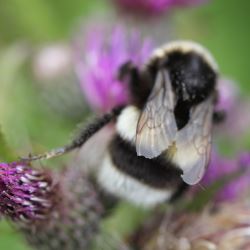
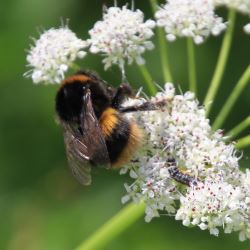 Two bees are regularly seen and reported – the White-tailed Bumblebee Bombus leucorum and the Buff-tailed Bumblebee Bombus terrestris. The species are easily separated by the distinctive colour of the dorsal tip of the abdomen.
Two bees are regularly seen and reported – the White-tailed Bumblebee Bombus leucorum and the Buff-tailed Bumblebee Bombus terrestris. The species are easily separated by the distinctive colour of the dorsal tip of the abdomen.
Common Black Ants Lasius niger can be found nesting under stones and will often reveal their companion species the Ant Woodlouse Platyarthrus hoffmannseggii.
The complete Lundy list of Hymenoptera may be viewed here.
Other groups
View the Lundy lists of Earwigs and Bristletails.
Text by Alan Rowland


